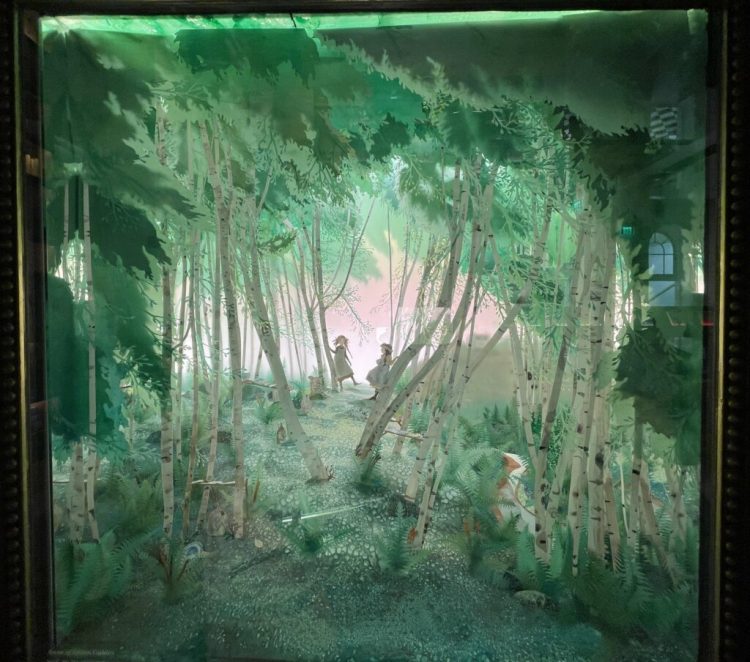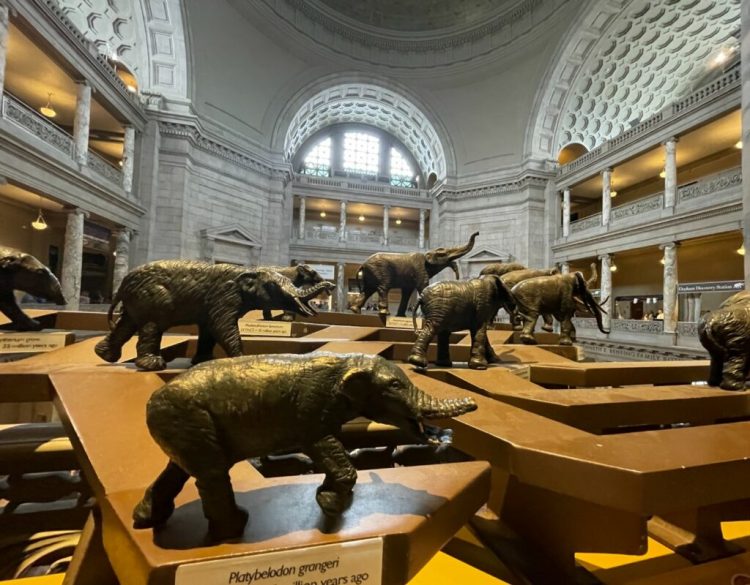Ravenna is, at first glance, very similar to other Italian towns. There are the houses in every shade of yellow from cream to orange. There are the leaning towers and the churches with scroll-top facades. There are the narrow cobblestone streets, the random gates where walls used to be, the statue of Garibaldi, the stone wells in courtyards, the loggias.
But there are a few nuances. The first, of course, is mosaics. Just as everyone I’ve read on the subject promised they are magnificent and impossible to describe or adequately photograph.
Here are a few photographs of Roman and Medieval mosaics. Note also the stone windows. The colored mosaics are mainly walls and ceilings, while the black-white-red ones are floors, and tend to be older.
And here are a few of the modern ones from the MAR museum
The beige rectangle below is a great example of why it’s pointless to photograph mosaics. It’s called Motion. It looks exactly like a field of dry grass in the wind – very alive and fascinating. One can spend a lot of time standing in front of it, but the photo is just a beige rectangle. I think part of the reason is that our eyes constantly move, and mosaics, especially deep ones like this one, change with the angle of view without the viewer consciously noticing the change except as a suggestion of life and movement.
And, of course, the street signs are also mosaics. And there are mosaic flowers all over to assure me that Ravenna is a friendly city for women.
Besides the mosaics there are less striking differences. Ravenna thinks of itself as a green city, and while it would not be considered particularly (or at all) green in North California it is more green than any other Italian city I saw. There are little “parks” everywhere – just squares with a few trees or bushes, but they do gladden the eye. And lawns, and trees. And there are at least three large parks, one of them in an old Venetian tower.
Another difference is the cult of Dante. Dante lived here after his exile, finished Paradise, and was repeatedly buried here.
There is not one, but two Dante museums and a learning center, and multiple statues of Dante. Note the two statues sharing a lawn, and two portraits of Dante sharing a wall. At first I thought that people wandering the streets wearing laurel wreaths and carrying bouquets were cosplaying Dante or on their way to offer him homage, but no – that’s part of the college graduation here. It was, however, a very natural mistake. Every day, at sunset chosen citizens come to Dante’s tomb to read a canto from the Divine Comedy. This started on the 700th anniversary of his death in 2021, and was supposed to only last one year, but they enjoyed it so much they plan to keep doing it forever.
In fact, Dante was not merely buried here once in 1321, near the cloister of St. Francis’ monastery. Dante burials are like Dante statues – why stop at just one? They do something with his bones every century.
In the 15th century they moved his sarcophagus into the cloister. In the 16th century the Florentines realized how wrong they’d been and started asking for Dante’s bones. This request was supported by the Medici popes (Florentine) and Michelangelo (employed by the Medici popes) and finally succeeded in 1519, but the Franciscan monks hid Dante’s bones in the wall. In 1677 they took the bones out and put them in a box. In 1781 the bones were put back into the sarcophagus and the whole thing moved into a brand new tomb outside of the cloister. To show how sorry they are Florence supplies the olive oil for the ever-burning lamp inside the tomb. In 1810 Napoleon came around and the monks hid Dante’s bones again. Florentines, meanwhile, sneakily bult another tomb for Dante in 1829 and waited. In 1865 the bones were found and put on display in a glass coffin, then re-buried again, disappointing the Florentines. In 1944 they were taken back out and hidden and re-buried in 1945, perhaps forever, but I bet Florentines are still hoping.
Below you can see the tomb, the glass coffin, the box, the place Dante’s bones were buried during WWII and the laurel leaves in jute bags designed by Gabriele d’Annunzio that were brought from Rome and scattered over Dante’s grave by four very brave pilots in 1921 on the 600th anniversary of his death.
But the coolest thing in that neighborhood is actually the crypt of St. Francis, where Dante’s funeral was held. St. Francis is a simple church, almost undecorated except for some fairly typical baroque frescoes, an elaborate animated nativity scene, and a lovely coffered ceiling. But their crypt is beautiful. It’s flooded (Ravenna sits on a marsh), covered with mosaics (of course), and populated by goldfish. Supposedly it contains the remains of bishop Neon who finished the construction of the city’s oldest standing monument, the Neonian baptistery (there’s also an Aryan baptistery built by the Ostrogoths half a century later). I am particularly glad to have seen it, because I’m unlikely to see the Istanbul cisterns and I have long wanted to. Of course, this isn’t the same – but columns, and water, and arches…
Yet another special thing about Ravenna is its history. It was the capital of Western Rome Empire in the 5th century, then the capital Odoacer, and then of the Ostorgothic kingdom (also 5th century) under Theodoric. Theodoric originally agreed to rule jointly with Odoacer, and they even held a banquet to celebrate this, but during the banquet Odoacer was somehow killed. Accidents happen. This is why so much of the architecture here is different – Ravenna’s important period came earlier than those of the surrounding cities.
In the 6th century it was taken over by Byzantines who proceeded to put mosaics everywhere the Ostorgoths missed. Having done that Byzantines were overwhelmed by the Lombars in the 8th century. Lombards were promptly overwhelmed by Franks led by Pepin the Short (first Carolingian king), who handed Ravenna to the popes. The popes showed their gratitude by encouraging Charlemagne (Pepin’s son, the important Carolingian king, first post-Rome emperor in the West) to take anything he liked from Ravenna to his capital in Aachen. He took a lot and Aachen definitely moved much higher on my list of places to visit after I saw what he left.
In the 13th century they had a lot of wars that ended up with the pope on top, but in the 15th century, just like everyone else around here, Ravenna was conquered by Venetians. Venetians built the awesome castle that is now a public park, and then the popes took over again and continued ruling all the way until unification of Italy in 1861, with a brief interruption for Napoleon.
All this means that they were relatively poor at the time when their neighbors were tearing down Romanesque churches and building Renaissance ones and couldn’t afford to destroy all the mosaics. In fact, Ravenna seems relatively poor even now. I haven’t seen churches with peeling ceilings and ivy climbing in through the windows in any other city. It also means that unlike their neighbors they had three kinds of Christianity – Aryan, Byzantine Orthodox, and Catholic, which makes the iconography refreshingly diverse.
The last different thing about Ravenna is that it is so quiet (and I say so despite the one loud restaurant they have that’s right under my window). There are few people on the streets, no lines anywhere, and in the MAR museum I was one of maybe a score people on the first floor (modern mosaics) and the only one on the second (everything else). Having empty museum rooms light up before me was interesting, but at the same time I felt oddly responsible to the artworks and probably looked at each of them more carefully than I would have otherwise.
Btw, did you know that the place where the Goths held on the longest was Crimea? Apparently there were some Gothic villages there as late as the 1940s. The Goth capital was Mangup, near Sevastopol. Their kingdom eventually was overwhelmed by the Huns in 5th century, but they kinda sorta held on as a Byzantine client state until the Khans came around in 15th century. It’s really amazing how much I don’t know about Ukrainian history.


































































































































































































































































































































































